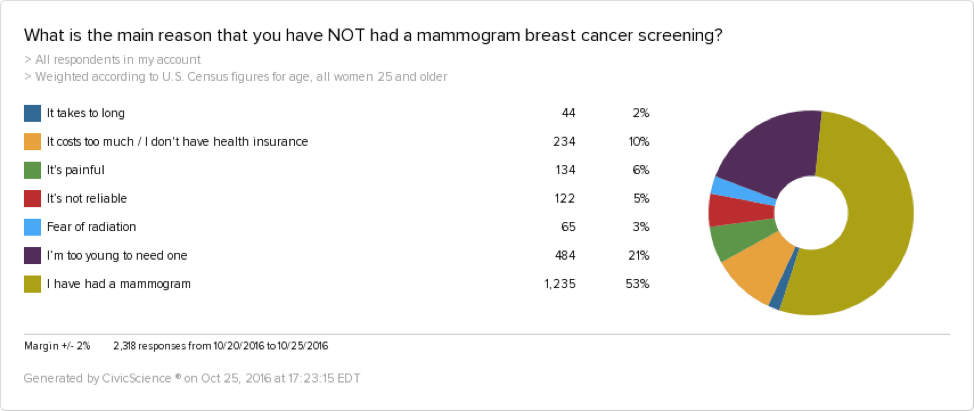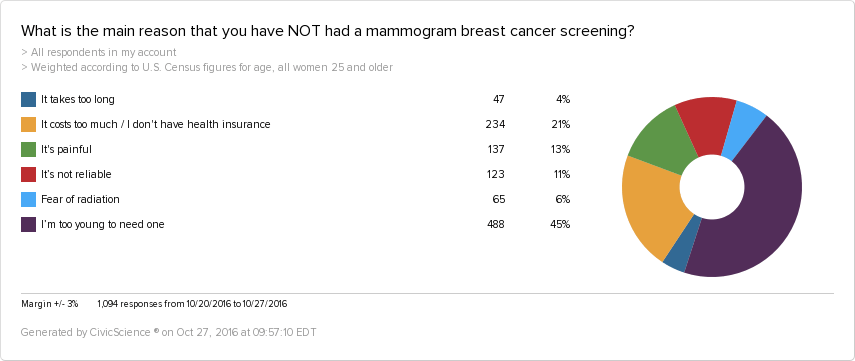In recognition of Breast Cancer Awareness Month, we recently wrote about breast cancer support and fundraising, and found fascinating insights about who has donated to fight breast cancer, and who hasn’t. And we didn’t stop there.
Medical professionals strongly suggest that women over 40 receive a mammogram to screen for breast cancer. For those who have had a family history of the disease, the recommended age for screening can drop to as low as 20.
Even though those recommendations are in place, many people still don’t go for exams. Why?
As you can see, 53% of women over 25 have had a mammogram. Among those who haven’t had one, the most common reason is that they’re too young.
Next seems to be concerns related to cost. Those who answered that mammograms cost too much, or that they don’t have health insurance, comprise 10% of those we asked.
When we take out those who have had a mammogram, we can see these common concerns much clearer. The simple insight we can derive is this: Price is still a strong barrier for breast cancer screening.
The Results Are In
As age is one of the strongest determinants of breast cancer, we wanted to take a look at the age makeup and general traits of the those with the most common concerns.
I Have Had a Mammogram (53%)
- Under 35: 4%
- 35-54: 45%
- 55+: 51%
These results are consistent with a 2014 study by the Society for Women’s Health Research (SWHR), showing that only 54% of women get mammograms. It seems there has not been much change in the last 2 years.
I’m Too Young to Need a Mammogram (21%)
- Under 35: 68%
- 35-54: 32%
- 55+: 1%
Though the majority of these people sincerely may be too young to need one, as we asked all women over 25, there are still 33% of folks in this group that are over the age of 35.
These insights may signal the need for stronger education and awareness about what age is recommended to have a mammogram.
Mammograms Cost Too Much / I Don’t Have Health Insurance (10%)
- Under 35: 20%
- 35-54: 51%
- 55+: 29%
This group has the highest portion of women ages 25 to 44 compared to all other groups. In addition, 29% of these folks are above the age of 55, and according to recommendations, should all have been screened for breast cancer already. Though price-effective options are available for breast cancer screenings, and free breast cancer screening is mandated under the Affordable Care Act, it’s clear that price remains a prominent barrier. Additionally, this group is more likely than the others to believe that their personal financial situation will worsen over the next six months.
They are also 2x more likely to be unemployed, more likely to smoke cigarettes, and more likely to drink coffee regularly. As a last note, we found that they are less likely to live in the U.S. Northeast, and are more likely to live in the U.S. Midwest.
Mammograms Are Painful (6%)
- Under 35: 14%
- 35-54: 45%
- 55+: 41%
Interestingly, we found that this group is more likely than the others to favor TV Sitcoms. To convince them of the ease and comfort of mammograms, especially due to new technology, these shows may provide a beneficial platform.
Additionally, we found that they are more likely to tell others about new brands and technology. If they were offered ways to try new mammogram technology, such as 3D mammograms, that may help to alleviate their worries, which they would be likely to tell others about as well. In other words, this group consists of the movers and shakers.
Mammograms Aren’t Reliable (5%)
- Under 35: 8%
- 35-54: 26%
- 55+: 66%
For this group that finds mammograms to be unreliable, there are two interesting points to note. First, they tend to be older, and are more likely to be over the age of 55. Next, this is the only group that consistently increases with age. It seems that the older someone gets, the less the think of mammograms. Why could this be?
Maybe it has to do with the fear of false positives and the stress that may cause. The Society for Women’s Health Research found that 47% of women reported being contacted for further testing after receiving abnormal mammogram results. These calls accompany fear, stress, and even sadness.
The organization says that these concerns may be alleviated by the growing use of 3D mammograms, which tend to be 10-20% more effective than older, 2D mammograms.
Ending Breast Cancer
In the last two years, even with improving technology, it seems that the number of women who have had a mammogram has roughly stayed the same. Our hope is that these insights can help change that trend for the better. If cost is a factor, which it definitely seems to be, we have to work harder to break down this barrier.
If you’d like to donate to fight breast cancer, check out the following organizations:
National Breast Cancer Foundation
Breast Cancer Alliance
National Breast Cancer Coalition Fund
Living Beyond Breast Cancer
To find more, or explore details about each organization, check out Charity Navigator’s resource for breast cancer charities.










